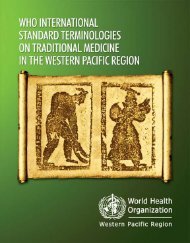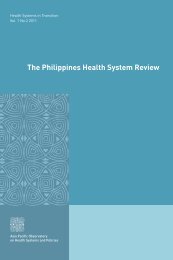Untitled - DOH
Untitled - DOH
Untitled - DOH
- No tags were found...
You also want an ePaper? Increase the reach of your titles
YUMPU automatically turns print PDFs into web optimized ePapers that Google loves.
National Framework Strategy on Climate Change Policy 2010-2022 HandbookFigure 1: Projected Changes in Annual Mean Temperature for 2020 and 2050,relative to the Baseline 1971-2000 by Region (PAGASA, 2010)Changes in Annual Mean RainfallThe PRECIS simulation exercise projects a change in annual precipitation from -0.5 to 17.4 % in2020 and -2.4 to 16.4 % in 2050. Increases in rainfall are particularly evident in most areas of Luzonand Visayas, while Mindanao is projected to undergo a drying trend. Average annual rainfall increaseover most parts of Luzon and the Visayas is expected to be 2 to 17 % by 2020 and 1 to 16 % by2050. In contrast, there is a general reduction in regional annual average rainfall in Mindanao (~ 0.5to 11 % by 2020; 2 to 11% in 2050)Figure 2: Projected Changes in Annual Mean Rainfall for 2020 and 2050, relativeto the Baseline 1971-2000 by Region (PAGASA, 2010)Sea level RiseSea level rise will increase the risk of flooding and storm damage. Projected impacts of 1 meter sealevel rise in many areas of the country show vast portions being inundated, affecting coastalsettlements and livelihood.According to estimates of the National Mapping and Resource Information Authority (NAMRIA), a onemeter sea level rise can translate to an estimated land loss of 129,114 ha.5. IMPACTS AND VULNERABILITIES5.1 Bio-Physical VulnerabilitiesFor purposes of the Framework and its corollary action plan, what are considered of primaryrelevance are the natural meteorological or meteorologically-influenced hazards faced by the3232
















